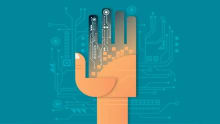Augmenting humanity: The next wave of digital

Let’s Talk Talent Read similar articles

The term “digital” has meant many things, so much so that today it sounds like a “passé” term. When people refer to “Digital 2.0”, they are talking about Augmented Humanity. Shakun Khanna, Senior Director – HCM Strategy and Transformation, Asia Pacific highlighted what this new wave of digital will mean to HR while addressing HR leaders in a CHRO Prime Series Roundtable on “Transformation in the age of digital imperatives.” This article will outline key insights from his session.
Augmented humanity is a term coined by Eric Schmidt, ex-CEO of Google which involves inserting technology deliberately in the way of normal life, to make it better. It is about envisioning a future where people and machines work together, each playing to their strengths, to achieve more significant outcomes. Take the example of the latest ad by Google Maps, #LookBeforeYouLeave which shows how you can assess multiple routes and know your time of arrival before you even reach your destination. So when we talk about augmented humanity in Digital 2.0, it means adding an extra layer of ability/capability through technology and not through Learning & Development alone.
Digital transformation has been about “enabling the existing capabilities and enriching human experiences”. The entire thrust is about building technologies that adapt themselves to the ways people think and work, rather than asking people to train themselves to learn how to use the technology. Technologies that can integrate themselves effortlessly into our lives, capitalize on our unique strengths, and amplify the best of human strengths.
Here is how the new wave of digital will enable machines and humans to collaborate and deliver better outcomes:
- Connected devices will deliver real-time information and analysis
Siloed and unconnected systems can’t deliver real-time information and analysis as integrated systems. Information is now accessible 24/7 on all devices, right from mobile phones, tablets to desktop computers. With a smartphone and data connectivity, employees can ensure that the client’s or a colleague’s email is answered on priority and keep their projects, ideas, and inspiration handy across all their digital devices. Collaboration tools will enable employees to work with colleagues, clients, and customers on the go. Soon, everything will be connected to a wireless channel(s) that will enable employees to access information at any time and anywhere
- Technology is moving towards natural language processing
The essence of people function lies in a cogent analysis of communication. Natural language is the most common medium of human interaction. A system without the ability to interact with people in their natural language will not be adopted by people and hence will not give you the desired outcomes. Natural language processing (NLP) can take text analysis to the much higher level of detail, granularity, and accuracy.• Empowering yourself with intelligent and Intuitive systems
Gallup’s Q12 Survey, aimed at measuring employee engagement includes a question, “I have a best friend at work.” The question today is not whether I have a best friend at work, but what does that best friend do for us at work?
The best friend at work is intuitive and intelligent. Similarly, with the use of technology, the moment we get intuitive and intelligence platforms in HR systems, it will help in analyzing and predicting the success of HR processes- recruitment, engagement, people behavior, etc.
The above three characteristics of the next digital wave integrate technology in the business to augment human capabilities.. Before you integrate these technologies, here are the three core imperatives you should know while we integrate machines to amplify our workforce capabilities:
- Understand the problem
For HR the problem statement should not be “what is the right technology for me?” but “how is technology impacting the socio-emotional behavior of my employees? How can we leverage the technology to drive social-emotional behavior? How people get hooked on to do right things with the right technology”
- Leadership Imperatives
According to Deloitte’s Human Capital Report 2017, digitizing HR, leveraging analytics in making talent-related decisions, and building an organization of future, etc. tops the priority list of the CHROs and HR Heads of the world. However, we are still not taking the control of the HR transformation entirely. HR transformation has to be the first agenda for the HR leaders today if they want to make an impact on the business. Robotics, Automation, IoT, AI, etc. are not the jargons but a reality that we need to embrace quickly to impact business and get results.
- Put your employees in front
The digital future technology would be about making technology look, sound and feel human. So make sure that you take the time to understand the kind of technology that is appreciated by your employee for its ease of use. Ensure that you run surveys, focus groups discussions with line managers and collect data with regard to the use of technology. For e.g. does your cloud-based office applications makes collaboration on documents and presentations easier and smoother? Siri, Google Assistant, and Alexa have revolutionized the landscape of Artificial Intelligence and Chatbots. They have been coded in a way to offer their users the most humane experience possible. The most successful technological platforms today have one common attribute– they address basic human wants.
The ultimate deciding factor that decides whether a technology will be adopted is its ability to be easy-to-understand, convenient, well-engineered, and optimized around people and their habits. With each passing year, technologies and innovations are reinventing how businesses are done, and talent is managed. The need of the hour is to understand the human strengths and machines' abilities and integrate them together to deliver better outcomes







